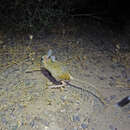en
names in breadcrumbs


Perception Channels: tactile ; chemical
US Federal List: no special status
CITES: no special status
IUCN Red List of Threatened Species: least concern
Allactaga elater carries and transmits disease. However, because of the arid, unpopulated region they inhabit, the danger isn't as prevalent as coming in contact with rodents in more highly populated areas of the world.
(Curtin, 1998)
Allactaga elater is used for its fur. They are poached by humans and their fur is used to make clothing and other fashionable objects.
(Curtin, 1998)
Allactaga elater obtains its food by burrowing in the sand or soil. They generally feed on seeds, insects and the succulent parts of plants. They do not require free water in nature or captivity because they obtain suffient amounts in their food.
(Funk and Wagnalls New Encyclopedia, 1986)
Allactaga elater is most commonly found in eastern Asia Minor and the lower Volga River to Sinkiang and western Pakistan.
(van Veen, 1998)
Biogeographic Regions: palearctic (Native ); oriental (Native )
Allactaga elater occupy desert regions.
(van Veen, 1998)
Terrestrial Biomes: desert or dune
Average lifespan
Status: captivity: 5.2 years.
Allactaga elater is commonly known as a small, five-toed jerboa. This jumping rodent has short front legs and long hind limbs. The hind limbs are usually four times as long as the front limbs and measure up to 10 cm. in length. Its body averages 15 cm. from head to tail. Allactaga elater is a sandy color on top and a whiter color underneath. The tip of the tail is usually black. Hair is also found under its feet to provide better traction in the sandy environments where it lives.
(Funk and Wagnalls New Encyclopedia, 1986)
Other Physical Features: endothermic ; bilateral symmetry
Average mass: 58.7 g.
Females give birth twice each year. The young are born in an average litter size of three. The gestation period for these small rodents is short, ranging from twenty days to four weeks, although the actual time is not known. After birth, the mother stays with her young for several months to protect and teach them until they are old enough to fend for themselves in the wild. The young reach sexual maturity in six weeks.
(Funk and Wagnalls New Encyclopedia, 1986; Britannica, 1999; Wood, 1998)
Key Reproductive Features: gonochoric/gonochoristic/dioecious (sexes separate); sexual
Average number of offspring: 4.5.
Average age at sexual or reproductive maturity (male)
Sex: male: 142 days.
Average age at sexual or reproductive maturity (female)
Sex: female: 142 days.